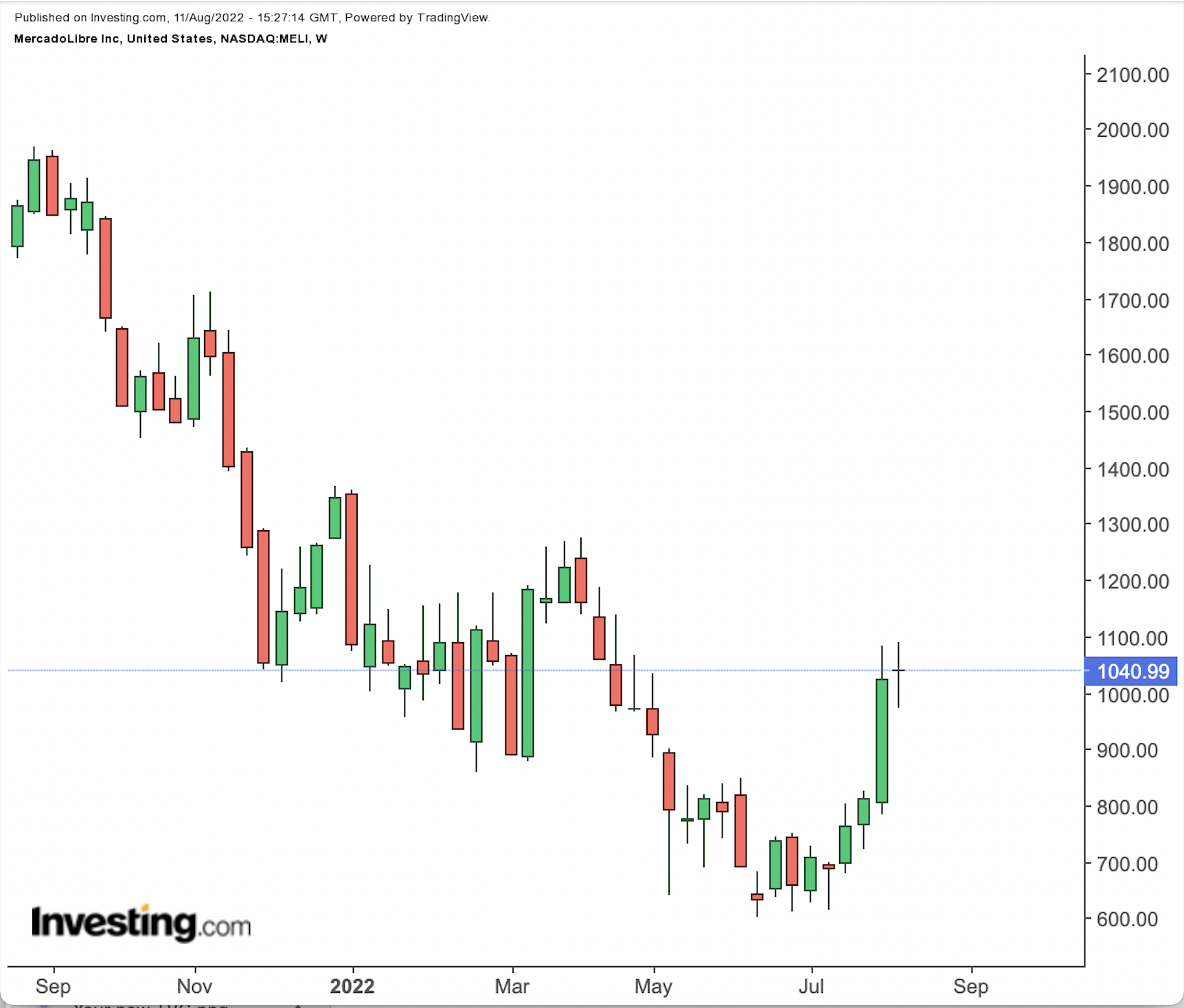- Blowout second-quarter earnings doubly impressive given context in which they were delivered
- MELI stock looks expensive — but the company remains profitable amid heavy investments in newer markets
- If current business trend continues, MELI stock trend should do the same
On its face, the second-quarter earnings report from MercadoLibre (NASDAQ:MELI) looks impressive. Revenue increased 52% as reported, and 57% on a currency-neutral basis.
Healthy operating margins of 9.6% were achieved on a GAAP (Generally Accepted Accounting Principles) basis, not excluding the stock-based compensation from so many companies that provide “adjusted” results. GAAP earnings per share increased 77% year-over-year.
MercadoLibre crushed analyst expectations on both the top and bottom lines. And so it’s little surprise that MELI has rallied, gaining 16% on the day after the earnings report and another 7% in trading on Wednesday.
Indeed, the stock now has rallied 77% from a two-year low touched in June. But after this quarter, there’s still a case for more upside ahead.

Source: Investing.com
Why MercadoLibre Earnings Are Doubly Impressive
Again, from a headline perspective, MercadoLibre earnings look impressive. But considering the environment, they’re even more so.
MercadoLibre often is referred to as the Amazon of Latin America. But in fact, the company is more than that. Its Mercado Pago service is something akin to Block (NYSE:SQ). Mercado Shops is much the same as Shopify (NYSE:SHOP).
What those three companies have in common is that they were so-called “pandemic winners.” MercadoLibre was no exception: demand for e-commerce and related services soared amid the impact on so many brick-and-mortar shops.
But what those three companies also have in common is a notable slowdown in growth in 2022. Amazon, for instance, grew revenue just 7.2% year-over-year in its second quarter — and those results were seen as “terrific.”
Between tougher year-prior comparisons and a declining interest in goods (in large part because so many consumers worldwide bought so many things in 2020 and 2021), the deceleration in revenue growth isn’t a surprise. But MercadoLibre is showing no signs of slowing down.
In fact, between the second quarter of 2019 and the second quarter of 2022, MercadoLibre’s net revenue increased almost fivefold. Operating income reversed from a loss of $12.5 million in Q2 2019 to a profit of $250 million three years later.
A number of retailers — online and otherwise — posted those kinds of growth rates for two years, only to see a “return to normalcy” prove a significant headwind here in 2022. MercadoLibre is not one of those companies. It’s still generating hugely impressive growth, which suggests there’s plenty of room for revenue and earnings to increase going forward.
Is MELI Stock Too Expensive?
To be sure, particularly after the bounce from June lows MercadoLibre stock is pricing in pretty substantial growth. Shares trade for about 160x this year’s consensus EPS estimate.
But those earnings are expected to more than triple this year and, on average, Wall Street sees 70% growth next year. And — as has long been the case with Amazon — headline figures don’t show the company’s true earnings power.
MercadoLibre still is losing money in its newer markets. Only in the most recent quarter did it become profitable in Mexico, one of the company’s most important markets. It takes time and capital to drive positive earnings, and in the meantime the fundamentals are going to look shaky.
For a couple of decades now, investors have been patient with a similar strategy from Amazon. MercadoLibre merits the same patience. It’s difficult, if not impossible, from the outside to calculate precisely how profitable the business could be right now, or will be in the future. But broad comparisons suggest there’s plenty of room for upside.
After all, Latin America has around 650 million people — a population nearly double that of the U.S. Admittedly, gross domestic product is far lower: only about one-fourth the American figure.
Still, Amazon (NASDAQ:AMZN) has a market cap roughly 25 times that of MercadoLibre. Yes, Amazon is worldwide, and Amazon Web Services drives a material portion of its valuation, but MercadoLibre is growing faster and has a chance at dominance greater than that of its American peer. Meanwhile, MercadoLibre’s valuation is barely ahead of that of Shopify or Square.
An Old Bull Case?
Broadly speaking, it does seem like the valuation here at least is reasonable, even if the headline earnings and sales multiples seem relatively high. And given the company’s growth rates, those multiples will come down steadily over time.
As always, there are risks. The obvious risk is that growth indeed slows down. Latin America was hit harder by the pandemic than other regions, and was later in its return to normalcy. It’s possible that 2022 results for the company will look like 2021 did for its North American peers, with the ‘hangover’ not arriving until 2023.
The other risk is that the bull case here sounds like a bull case from 2020 and 2021, when investors focused on growth over valuation. That changed in a hurry this year, when so many growth stocks — MELI among them — plunged back to Earth. Even if MercadoLibre continues to drive growth over the long term, short-term volatility may still plague MELI stock.
For now, those risks seem worth taking. The bull case here is a 2021-style case, but what MercadoLibre's earnings show is that, so far, the company isn’t likely those fallen angels. Its growth is holding up, and as long as it does, MELI stock should be fine.
Disclaimer: As of this writing, Vince Martin has no positions in any securities mentioned.
